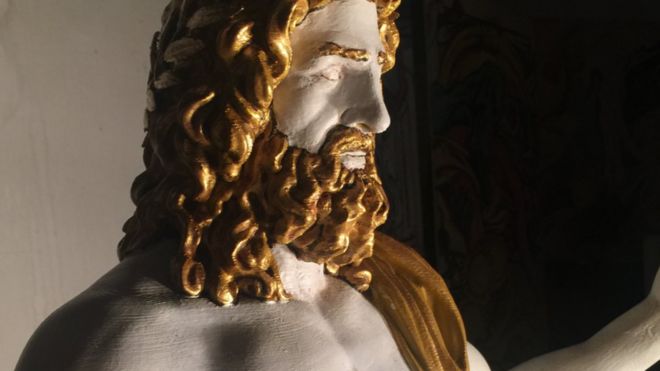A few days ago, in the spirit of the Olympics, I posted about ancient Olympia. As the site of the ancient Olympics, the site boasted some truly spectacular features, including a seated statue of Zeus that stood inside His temple. The statue has recently been recreated--by way of 3D printing.
3D printing firms Stratasys and 3DPTree made the recreation for the Millennium Gate Museum in the US city of Atlanta. The 3D-printed version stands at a modest 1.8 meters and was printed in thermoplastics, using a 3D model that approximated the design of the statue.
It took two days to 3D-print Zeus' body and another 20 hours for his legs. After some finishing of the statue's surface, the pieces were shipped to another location for assembly. Jesse Roitenberg at Stratasys stated about the project:
Susanne Turner, curator at the Museum of Classical Archaeology in Cambridge, who was not involved with the project but has followed it closely states:
The seated statue, created by the sculptor Phidias, was thirty-nine feet, or twelve meters, tall. The statue was richly decorated with ivory and gold-plated bronze. The sculpture was wreathed with golden olive shoots and sat on a grand throne of cedarwood, inlaid with ivory, gold, ebony, and precious stones. He held a small statue of crowned Nike, goddess of victory, in his right hand, and in his left hand, a sceptre inlaid with gold, on which an eagle perched.
The statue was eventually destroyed, either in the fire that also destroyed the temple, or before, when it was carried off by Romans who either used the stone and precious metals to create something new, or to repurpose the statue as a representation of one of their own emperors.
3D printing firms Stratasys and 3DPTree made the recreation for the Millennium Gate Museum in the US city of Atlanta. The 3D-printed version stands at a modest 1.8 meters and was printed in thermoplastics, using a 3D model that approximated the design of the statue.
It took two days to 3D-print Zeus' body and another 20 hours for his legs. After some finishing of the statue's surface, the pieces were shipped to another location for assembly. Jesse Roitenberg at Stratasys stated about the project:
"It's not just for engineers, it's not just for designers - it's for art, it's for archaeologists."
Susanne Turner, curator at the Museum of Classical Archaeology in Cambridge, who was not involved with the project but has followed it closely states:
"Often, studying the ancient world is like trying to put the pieces of a jigsaw puzzle back together - but you've lost the cover with the picture and half the pieces. Anything that allows academics and interested members of the public to be able to visualise and imagine what these lost things may have looked like is an extremely powerful tool. I think [3D technologies] are going to become increasingly important, because it's so terribly distressing that those artefacts were lost."
The seated statue, created by the sculptor Phidias, was thirty-nine feet, or twelve meters, tall. The statue was richly decorated with ivory and gold-plated bronze. The sculpture was wreathed with golden olive shoots and sat on a grand throne of cedarwood, inlaid with ivory, gold, ebony, and precious stones. He held a small statue of crowned Nike, goddess of victory, in his right hand, and in his left hand, a sceptre inlaid with gold, on which an eagle perched.
The statue was eventually destroyed, either in the fire that also destroyed the temple, or before, when it was carried off by Romans who either used the stone and precious metals to create something new, or to repurpose the statue as a representation of one of their own emperors.


No comments:
Post a Comment